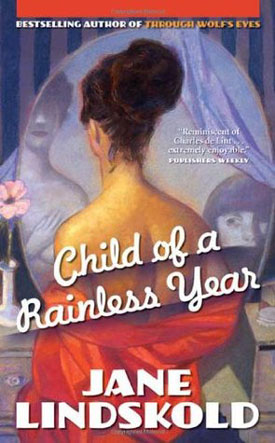 Jane Lindskold is one of the more adventurous authors working in the mode of speculative fiction. From her transparent contributions to Roger Zelazny’s last two books through the contemporary urban fantasy of the athanor novels through the more-or-less “classic” fantasy world of Through Wolf’s Eyes, she has shown not only great ease in moving among subgenres, but a remarkable proficiency in pushing the envelope stylistically without becoming precious, an affliction suffered by many in the field. Child of a Rainless Year, although certainly not beyond the pale in terms of mainstream fiction, shares some characteristics with such breakthrough genre-benders as Samuel R. Delaney’s Dhalgren or Roger Zelazny’s Creatures of Light and Darkness. By the same token, it may leave some readers of fantasy dissatisfied, to which I can only respond, “Get over it.”
Jane Lindskold is one of the more adventurous authors working in the mode of speculative fiction. From her transparent contributions to Roger Zelazny’s last two books through the contemporary urban fantasy of the athanor novels through the more-or-less “classic” fantasy world of Through Wolf’s Eyes, she has shown not only great ease in moving among subgenres, but a remarkable proficiency in pushing the envelope stylistically without becoming precious, an affliction suffered by many in the field. Child of a Rainless Year, although certainly not beyond the pale in terms of mainstream fiction, shares some characteristics with such breakthrough genre-benders as Samuel R. Delaney’s Dhalgren or Roger Zelazny’s Creatures of Light and Darkness. By the same token, it may leave some readers of fantasy dissatisfied, to which I can only respond, “Get over it.”
As a child, Mira Bogatyr lived in an exotic old Victorian house in Las Vegas, New Mexico, with her mother, the glamorous Colette, and the “silent women.” When Mira is nine, Colette disappears, and Mira is sent to live with Steven and Maybelle Fenn, who eventually adopt her, although she continues to call them “Uncle Steve” and “Aunt May.” When Mira is in her early fifties, Uncle Steve and Aunt May are killed in an automobile accident, and it becomes necessary for her to manage the estate she inherited from her mother. She goes to Las Vegas to look at the house she still owns and decide what to do with it — her assumption is that she will fix it up and sell it. She meets Domingo Santiago, who has been the caretaker of the property. And, as they begin to renovate the house — a gangling and incredibly ornate Queen Anne Revival — the silent women reappear. Mira begins to learn more about her mother’s disappearance. And, it seems, the House itself is beginning to wake up.
I’m hard put to think how to describe this novel in any sort of clear terms. It has elements of the supernatural, the cognitive disjunction of bizarre events in an everyday setting, the dreamlike, surreal quality of much Latin American fiction — that sense of history as a multivalent continuum that somehow never lets us go. “Magical realism” seems the most appropriate comment, that heightened awareness of a dream state coexisting with the mundane that calls to mind Delaney, Garcia Márquez, or Pynchon.
I think I have in common with most readers some impatience with a novel or story that doesn’t move quite fast enough — that largely intangible and highly subjective thing we call “pacing.” Child of a Rainless Year is not a fast-paced tale, certainly not the kind of adventure story we think of when we think of “fantasy,” whether it be heroic, urban, or supernatural thriller. It is, however, one of those books that I found very difficult to put down, and it frustrates me to a certain extent because I’m not really sure why. The things that happen are small, largely undramatic, sometimes almost off-hand. At 400 pages, it’s not what I can call a “lean” book, although it’s certainly not florid. It is itself, much as Mira is herself and Colette was always herself. To call it thoughtful is certainly accurate, but it’s a kind of thoughtful that sticks pretty much to the point — even the digressions come looping back around to the story fairly quickly, and add another piece to the puzzle. It is really a story of revelation, a coming-of-age tale told by a woman in her fifties who has spent her life being respectable, and who now has to learn to accept a heritage that is, to say the least, unusual.
Lindskold has managed to bring an amazing sense of reality to this story — the growing romance between Mira and Domingo, who is himself aware of the House and its wants, is told in the small details of working on the renovation, those small hesitancies and inadequacies felt by all but the most self-assured of us when faced with someone both attractive and sympathetic, while the research into Colette’s disappearance is a matter of lawyers, police officers, a newspaper reporter, small fragments that gradually begin to build a picture.
The idea of a “literary” fantasy novel still strikes many readers as unusual, if not an outright contradiction in terms. Those of us familiar with the field, of course, know better. I would advise anyone who harbors such suspicions to read Child of a Rainless Year. This is a spectacularly good book, with much more to it than I can hope to examine in anything as necessarily brief as a review — it is as close to perfect as anything I’ve encountered in a long time.
(Tor Books, 2005)
